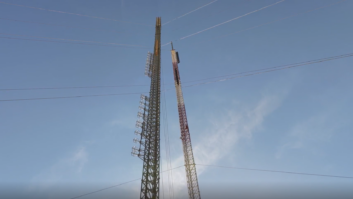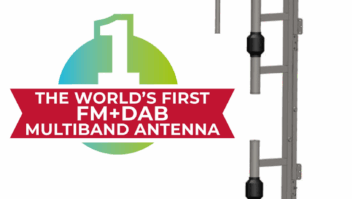Early NPR Labs Data Favor Passive HD-R Receiver Antennas
WASHINGTON: Folded FM dipoles are among the passive antenna types suitable for optimal reception of the digital signal with the Boston Acoustics Recepter Radio HD.
That’s the conclusion of early test results from NPR Labs personnel, who are conducting coverage and signal strength tests of antennas for use with that radio.
NPR Labs focused on that model because it’s the only lower-priced tabletop HD Radio available. Also, the network has helped member stations purchase quantities of that receiver at favorable rates; and it wants consumers to have a good experience with their HD-R radios, said John Kean, head of Labs Measurements and Research for NPR Labs.
“Because of the cliff effect of digital, we did hear comments from some stations and listeners through stations that couldn’t get the FM to work on HD,” he said. NPR Labs is the networks’ research arm providing data to public radio stations.
‘Rat tail’
Meanwhile, Boston Acoustics in April addressed complaints in that area. The receiver maker told Radio World it would begin packaging a second FM antenna, a stronger conventional dipole, with its units to improve reception, especially in fringe areas.
Prior purchasers can contact the supplier to request the antenna at no cost.
The Recepter experience is being watched closely by an industry eager to know how HD Radio will be perceived by consumers.
Recepter Radio HD models will have the additional antenna included, so the units now will come with four: an internal AM, an external AM, the pre-attached short wire or so-called “rat-tail” FM antenna and the new FM dipole. Radio professionals and consumers can call (978) 538-5000 and ask for parts and service to obtain an antenna for a radio they purchased earlier, said Boston Acoustics spokeswoman Colleen Cronin.
Several engineers had complained to the company and grumbled in online technical postings that the original 18-inch, single-wire FM antenna did a poor job of detecting digital signal in fringe areas. These engineers generally commented that BA had made a good radio but supplied an inexpensive antenna.
To that criticism, Jeff Cowan, director of training and product support said, “The decision to include that antenna was not driven by cost,” but rather by determining whether the product met performance criteria with the least intrusive antenna.
“T-shaped wires end up not being used in many homes,” Cowan said. “People think the dipole is ugly.”
For that reason, most consumers don’t fully stretch out the dipole but leave it in a clump on the floor, he said, which argued against including such an antenna. Also, he said, the product performed well in field-testing with the rat-tail antenna.
The new FM dipole included with the radio “is very thin,” said Cowan
BA still leaves the rat-tail antenna attached to units it ships; it thinks most consumers will continue to use that antenna. The company is including the FM dipole in the receiver packaging and had it manufactured to fit the 75-ohm connector on the back of the Recepter HD, so it wouldn’t require a big connector. Most dipoles are built to fit a larger, 300-ohm connector, Cowan said.
Cowan said BA has gone to “considerable expense” to make the antennas available and compatible with smaller connectors.
But, Cowan said most consumers are happy with the product and demand is high, and the majority of complaints seemed to come from radio industry professionals listening in offices with steel construction, he said. BA had field-tested the Recepter HD in homes with wood construction.
One commercial radio group engineer commented to Radio World, “The BA Radio sensitivity is an issue, and it’s not just in commercial buildings, although those are probably worst-case. A table radio lives a tough life and generally has a non-optimum antenna; most analog FM sets use the power cord.”
The table on which a radio sits is “almost always inside a structure of some sort that nicely attenuates the signal before the poor receiver even gets to sample it,” said the engineer, who added, “Obviously that attenuation is worse in a commercial structure, which generally offers a lot more signal attenuation than, for instance, a typical house.” He said the new antenna likely would improve the digital reception.
Cowan said digital radio’s lower signal strength, 20 dB below analog, is probably a factor as well.
NPR Labs said that, in some cases, analog reception of hybrid stations has been adequate but HD Radio reception has dropped in and out or been nonexistent.
‘Learning curve’
Some engineers had complained privately to Radio World that they had to supply stronger antennas for the use of station employees. Whether consumers would go to the trouble of buying additional antennas to support this model has raised concern among the engineering community, who worried about an early negative consumer reaction to the digital radio experience.
Industry observers told Radio World they were glad Boston Acoustics made the change.
Mike Bergman, vice president, New Digital Technologies, Kenwood USA, said there’s extra scrutiny from early adopters and industry professionals on Boston Acoustics because it developed the first HD tabletop model.
“The early adopters tend to be more forgiving than the mainstream consumer. The professionals know way too much to let anything go.”
He applauded the company for including the extra antenna.
“People don’t realize how difficult and expensive it is to step up to the plate like this. I suspect the early adopters of a technology like HD Radio may be more willing to go the extra step to install a dipole antenna.”
NPR, like other broadcasters, had purchased a large number of units, and a BA spokeswoman said, “there has been a lot of dialogue between NPR and BA” on this topic.
“There’s been a learning curve for all involved with this new format, including broadcasters and Ibiquity, which provided the specs Boston used to develop the radio,” said Cronin.
Mike Starling, NPR’s chief technology officer and head of NPR Labs, said of the certification test results, “The Boston Acoustics Recepter HD measures at NPR Labs as having very good inherent FM HD sensitivity, but it’s no surprise that the short supplied antenna does not perform as well as other separate antennas in challenging indoor locations.
“There has been some suggestion that amplified antennas work better in such locations, but our NPR Labs measurements show the best results come when using relatively inexpensive passive antennas where needed.”
Testing
Meanwhile, NPR Labs conducted test results from five Washington/Baltimore-area stations and continues to gather data to support NPR’s HD-R receiver certification process. It hopes to issue a report later this year.
NPR Labs has been testing the Kenwood, JVC and Panasonic aftermarket car radios for performance. It’s also planning to test the DaySequerra HD Broadcast Reference tuner and the Belar HD-R monitor later this year.
Initial results were released in a field service bulletin “IBOC Field Service Bulletin No. 02,” intended to help stations and consumers choose antennas that are effective in improving reception. The bulletin is available on the NPR Labs Web site www.nprlabs.org under the Field Service Bulletins tab.
NPR Labs obtained several amplified and passive FM receive antennas to evaluate performance with HD Radio signals on the Recepter HD: Folded dipole, compact amplified FM-only antenna, compact amplified FM/AM antenna and rabbit-ear FM antenna.
“Preliminary testing shows a clear advantage to passive antennas, such as folded dipole and rabbit-ear types, over low-cost active antennas,” states NPR in the bulletin.
The five FM stations used in the tests are WAMU 88.5 MHz, Washington; WETA 90.9 MHz Washington, transmitting from its Arlington Va. transmitter; WBJC 91.5 MHz Baltimore; WASH 97.1 MHz Washington and WTOP 103.5 MHz Washington.
WAMU, WETA and WBJC are noncommercial stations while Clear Channel Radio owns WASH and Bonneville International owns WTOP.
The spectrum plots that accompany this article show an example of the performance difference between a 75-ohm folded dipole antenna and an active FM-only antenna. These figures show the spectrum measured from 88 to 108 MHz at the NPR’s Washington headquarters. The antennas were placed on a large empty nonconductive cardboard box approximately 5 feet from a north-facing, fifth-floor window.
“The spectrum of the folded dipole shows most FM station signals ranging between 30 dBm and 50 dBm (measured with a 50-ohm spectrum analyzer input). WBJC, a Baltimore station, is shown at approximately 69 dBm,” states NPR Labs in the bulletin. “The noise floor, which is a combination of analyzer internal noise and low-level FM signals, is below 90 dBm.”
NPR Labs goes on to state in the bulletin: “The gain control of the active FM-only antenna was adjusted so that the level of FM signals near the middle of the band were approximately equal to the levels measured with the folded dipole. This occurred at a rotation about 1/3 clockwise from minimum. It is apparent that gain of the antenna unit is not flat across the band. The reserved band (88-92 MHz) stations are at least 10 dB lower with the active antenna.
“The WTOP signal is approximately 20 dB higher than it was with the folded dipole. However, this signal increase is accompanied by a noise floor increase of nearly 30 dB so the net signal-to-noise ratio is decreased by approximately 10 dB. The signal-to-noise ratio for the reserved band stations is even worse; note that weak WBJC is almost lost in the noise.”
This performance was typical of other amplified antennas tested that sell for under $70, according to NPR Labs, which also notes, “The source of noise in amplified FM antennas is likely to be third-order and fifth-order intermodulation products generated by the internal amplifier. Adjustment of the gain control lower will reduce the IM product levels, but also reduces the signal levels below that of the sample dipole antenna.”
NPR purchased a number of Recepters for its member stations and Starling noted the buy was “fully subscribed in just a few days last November.” Since then, the network has received requests from a anumber of stations looking for more receivers as soon as they can get them, he added.





